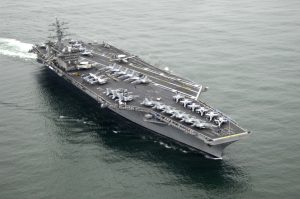 India’s long awaited Light Combat Helicopter (LCH) in works since 2006 finally flew after months of speculation. Hindustan Aeronautics Limited (HAL) had announced that the attack helicopter will take to skies for the first time in February 2010 but it didn’t happen. The LCH finally flew on March 29 which was a rather quite affair with only the HAL engineers forming the spectator base. The Monday’s test was not an official test according to HAL but was just a confidence building flight. The official test flight will take place sometime in April in front of VIP’s and defense staff.
India’s long awaited Light Combat Helicopter (LCH) in works since 2006 finally flew after months of speculation. Hindustan Aeronautics Limited (HAL) had announced that the attack helicopter will take to skies for the first time in February 2010 but it didn’t happen. The LCH finally flew on March 29 which was a rather quite affair with only the HAL engineers forming the spectator base. The Monday’s test was not an official test according to HAL but was just a confidence building flight. The official test flight will take place sometime in April in front of VIP’s and defense staff.
Plan to develop attack helicopter was finalized in October 2006 after the design concept developed by HAL was approved by the Indian Army and the Indian Air Force. Need for a modern attack helicopter platform was felt by the Indian military during late 90s when its attack helicopter fleet comprising of some 80 Russian Mi-24s and Mi-35s proved to be useless at high altitude and lacked sophistication needed by complex modern wars. It was decided to develop an attack helicopter which could fulfill the unique and different needs of the Army and the Air force.
LCH was designed out of HAL’s highly successful multi-role utility helicopter “Dhruv”. Dhruv first entered service in 2002 and since have carried out its duties in a very successful manner. Dhruv is also being exported to many countries. Developing LCH from Dhruv saved HAL preciously needed time. So far the IAF has placed an order of 65 LCH’s and the Army has placed an order of 114. According to estimates the LCH should receive its Final operational clearance by 2013 after which it will enter service.
LCH was designed with stealth in mind and hence it has a narrow fuselage and flat panels and some other stealthy features. Pilot seating is in tandem configuration because of the narrow fuselage. It has an armor designed to withstand an attack from a 12.7mm bullet. It also has crashworthy cockpit to protect the pilots, this feature has been taken from Dhruv’s design. LCH is expected to perform multiple roles like Air defense against UAV’s, attack operations against enemy air defenses, escort for other helicopters, counter offensive against ground forces on both conventional and urban battlefield, counter insurgence, combat search and rescue operations, anti-tank role and scout duties in all weather conditions and in day or night. It will also function at high altitude areas of Jammu and Kashmir and Arunachal Pradesh. LCH is also capable in Nuclear-Chemical and Biological scenarios.
LCH’s advance avionics will feature a full glass cockpit and helmet mounted sight and display. LCH also features an advance electronic warfare suit (EWS) and Directional Infrared counter measures (DIRCM) for self-protection. LCH has data link capability hence it can communicate with other assets. Other common features like fuel consumption display, Infrared and flame suppressor, digital video recorder, etc will also be incorporated into the aircraft.
Multiple weapons will be carried by the LCH like rockets, air to air missile, air to surface missiles, cluster bombs, anti-radiating missile and turret gun developed by Nexter of France. It can take off from an altitude of 10,000 feet, operate weapons up to 16,300 feet, and engage targets like UAVs that are flying at altitudes of up to 21,300 feet. LCH is capable of carrying more than 2000 kgs of armament. Max takeoff weight of the LCH is around 5.5 to 5.8 tones; its top speed is 275 kms and range of 550 kms. Service ceiling of LCH has been extended to 6.5 kms. Once service ready the LCH is expected by the HAL to be one of the best attack helicopters in the world, this is crucial as the Indian forces have fallen behind the Pakistani’s and Chinese who have advance attack helicopters.
Author: Pratik Sawerdekar


